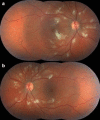Arboviruses and the eye
- PMID: 28163928
- PMCID: PMC5286683
- DOI: 10.1186/s40942-016-0057-4
Arboviruses and the eye
Abstract
Arthropod-borne viruses, or arboviruses, are viruses that are transmitted through the bites of mosquitoes and ticks. There are numerous arboviruses throughout the world capable of causing human disease spanning different viral families and genera. Recently, dengue, chikungunya, and zika viruses have emerged as increasingly important arboviruses that can cause human disease, however no specific treatment or vaccine is available for them. In addition, ocular manifestations of these diseases have become more prevalent over the past few years. This review highlights the current understanding on the pathogenesis, systemic changes and ocular findings, emphasizing the retinal manifestations related to dengue, chikungunya, and zika viruses.
Keywords: Arboviral disease; Arbovirus; Brazil; Chikungunya virus; Dengue virus; Ocular manifestations; Retinal manifestations; Zika virus.
Figures



References
Publication types
LinkOut - more resources
Full Text Sources
Other Literature Sources
Miscellaneous

